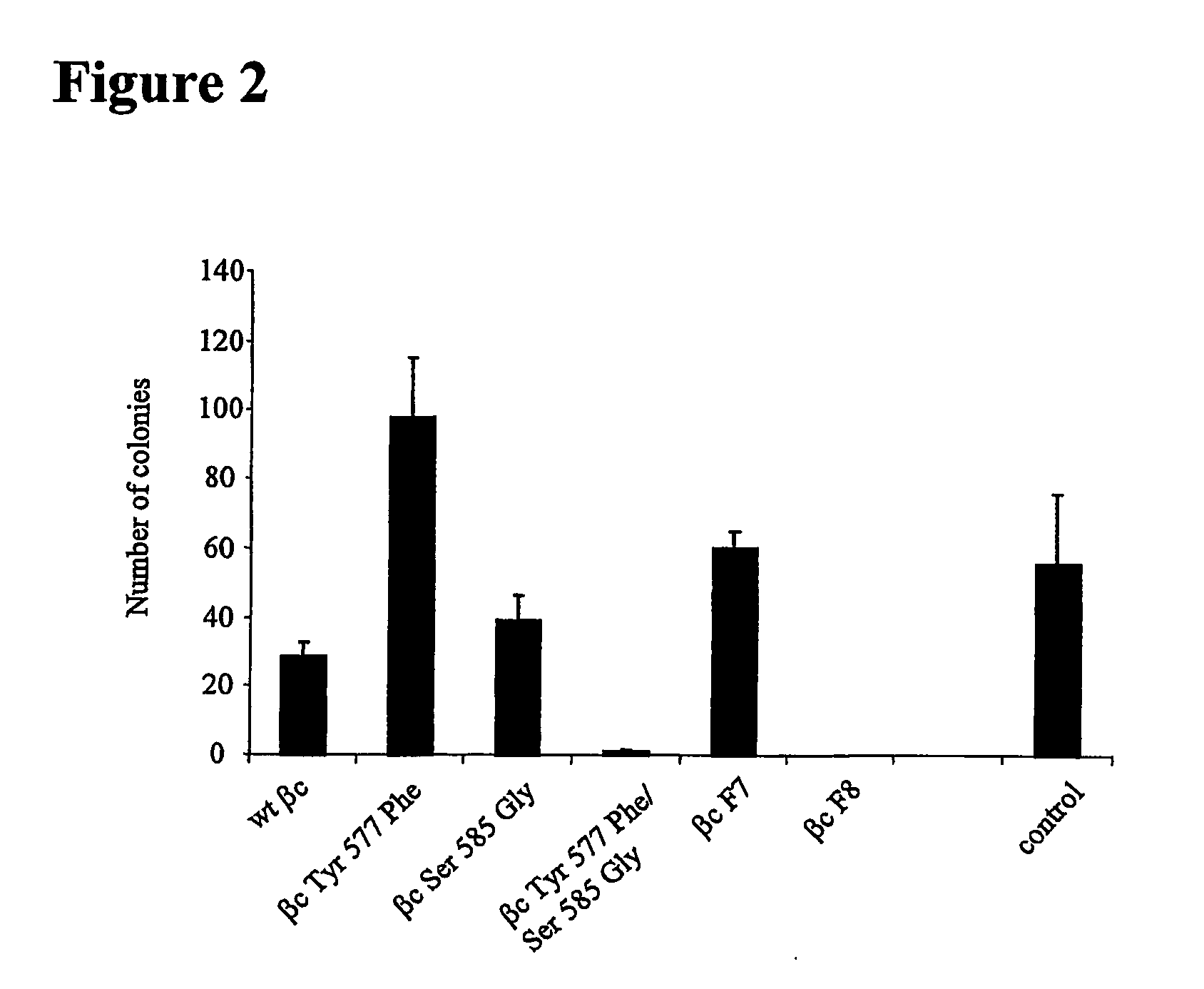Bidentate motif and methods of use
a technology of tyrosine phosphorylation and motif, which is applied in the field of tyrosine phosphorylation, can solve the problem that the phosphorylation of receptor tyrosine cannot be solely accountabl
- Summary
- Abstract
- Description
- Claims
- Application Information
AI Technical Summary
Benefits of technology
Problems solved by technology
Method used
Image
Examples
example 1
Role of Ser585 on βctyrosine Residues in the Ability of GM-CSF to Regulate Primary Haematopoietic Cell Function
a) Transduction of Primary Fetal Liver Cells
[0227] The ability of wt and mutant βc to transduce specific biological responses following GM-CSF stimulation was assessed in primary mouse hemopoietic cells derived from fetal livers. Fetal liver cells were harvested from E12.5 mice and transduced with bicistronic retroviral constructs for the expression of both the α subunit (GMRα) and the βc subunit of the human GM-CSF receptor. Human GM-CSF receptors were transducted into a β subunit null background using fetal liver cells derived from βc − / −βIL-3 − / − double knockout SV129 mice. For these transductions, Ψ2 retroviral packaging cell lines were firstly stably transfected with constructs for the wild type GM-CSF receptor (pRUF-IRES-GMRαβc) and mutant receptors (pRUF-IRES-GMRαβcTyr577Phe, pRUF-IRES-GMRαβcSer585Gly, pRUF-IRES-GMRαβcSer585Gly / Tyr577Phe, pRUF-IRES-GMRαβcF8 and pR...
example 2
The Ability of the Wt and Mutant βc to Specifically Promote Cell Survival or Proliferation in Response to GM-CSF
[0234] The ability of GM-CSF to promote cell survival was determined by annexin V-FLUOS staining essentially as recommended by the manufacturer. Transduced fetal liver cells were plated in IMDM and either 0.1% or 10% HI FCS, containing either no GM-CSF, 50 ng / ml hGM-CSF or 1:1000 pro-survival cocktail (IL-6 / EPO / G-CSF). After 48 hours, cells were harvested and stained firstly with the 4H1 anti-GMRα monoclonal antibody and an anti-mouse IgG-PE antibody and secondly with annexin V-FLUOS. Viable cells (annexin V-FLUOS-negative) expressing the GM-CSF receptor (GMRα-positive) were analysed by flow cytometry.
b) Colony Assays
[0235] The response of immature cells to GM-CSF was analysed using colony formation assays. Fetal liver cells were transduced and expression of the GM-CSF receptor quantitated as described above. Colony forming cells were assayed usi...
example 3
The Ability of GM-CSF to Promote the Survival of Fetal Liver Cells Transduced with the βcSer585Gly Mutant Under Low Serum Conditions
[0238] While our previous studies had demonstrated a defect in GM-CSF-mediated survival for the βcSer585Gly mutant in the CTL-EN cell line, data presented here indicates that this mutant was not defective in promoting either colony formation (FIG. 2) or survival (FIG. 3A) of primary hemopoietic cells in response to GM-CSF. However, the experiments presented here with fetal liver cells were performed in the presence of 10% FCS which we have previously observed to mask the survival defects of some βc mutants. Fetal liver cells expressing either wtβc or βcSer585Gly were plated out in 0.1% FCS and either no factor, GM-CSF or control cocktail. Under these conditions, GM-CSF was able to promote the survival of fetal liver cells expressing the wtβc but not the βcSer585Gly mutant (FIG. 3A). These results would indicate that the Ser585 survival pathway that was...
PUM
| Property | Measurement | Unit |
|---|---|---|
| time | aaaaa | aaaaa |
| pH | aaaaa | aaaaa |
| hydrophobic | aaaaa | aaaaa |
Abstract
Description
Claims
Application Information
 Login to View More
Login to View More - R&D
- Intellectual Property
- Life Sciences
- Materials
- Tech Scout
- Unparalleled Data Quality
- Higher Quality Content
- 60% Fewer Hallucinations
Browse by: Latest US Patents, China's latest patents, Technical Efficacy Thesaurus, Application Domain, Technology Topic, Popular Technical Reports.
© 2025 PatSnap. All rights reserved.Legal|Privacy policy|Modern Slavery Act Transparency Statement|Sitemap|About US| Contact US: help@patsnap.com



